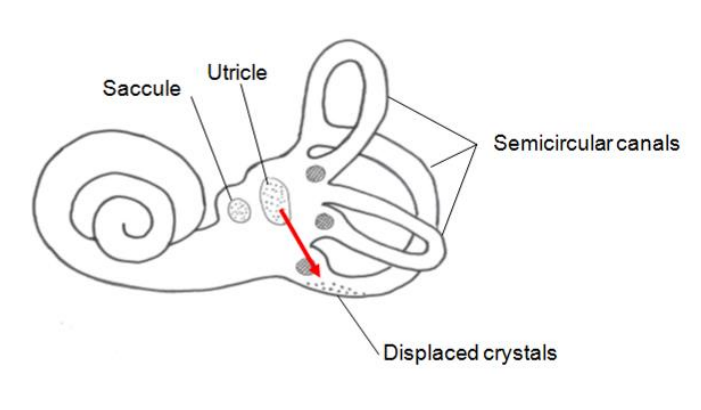Benign Paroxysmal Positional Vertigo (BPPV)
What is BPPV?
BPPV is a common cause of vertigo and can affect one or both ears. It is more common with increasing age. It is an inner ear balance disorder. The balance organ on each side has:
- The utricle which detects movement up or down
- The saccule which detects movement from side to side, and forwards and backwards
- The three semi-circular canals which detect rotation in three planes.

The utricle and saccule have receptor hairs loaded with tiny chalk-like crystals which help to detect small movements of your head. Some of the crystals from the utricle can become loose (this can happen after a head injury, after an ear infection or for no reason that we know of) and drift down through the fluid of the inner ear and end up in one of the semi-circular canals. This causes the symptoms of BPPV when the head is turned, because the receptors in this semi-circular canal are stimulated more than they should be because of the extra loading from the displaced crystals and this produces vertigo.
What are the symptoms of BPPV?
The typical symptom is short-lasting vertigo (dizziness), described as a spinning or falling sensation. This can be triggered by rolling over in bed, lying back in bed or sitting up from a lying position, looking up or bending forward. You may feel a bit sick when you have the vertigo. The feeling of vertigo only lasts for half a minute to a minute, and it will not happen unless you move your head in particular ways. You may have several episodes per day, but between the episodes you may have no problems with your balance at all.
BPPV will usually settle over a few months without any treatment, but may come back again, usually within the first year.
There are three types of BPPV depending on which of the three semi-circular canals in the inner ear is involved. The majority of cases (85%) are from the posterior canal and the following description just applies to that type of BPPV.
How is BPPV diagnosed?
Usually from the history of short-lived episodes of vertigo, only happening after movement, and a positive positional test performed in the clinic. The first part of the test begins with you sat upright on the couch, with your head turned to one side and extended. The second part involves the doctor holding your head with his hands, supporting you as you move into the laying position. During the transition from sitting to laying, the doctor will be looking at your eyes. If you have BPPV on this side you will feel the vertigo coming on after a few seconds. The doctor is looking for some rotatory movements of your eyes when you have the vertigo, so will ask you to keep your eyes open. The vertigo will only last about 30
seconds. The test is then repeated looking to the other side.
How is BPPV treated?
In some cases treatment is not needed, perhaps because the condition is starting to improve and the episodes of vertigo are settling down with time. In other cases, the vertigo is persisting and treatment is recommended. This is not a condition which will be helped by drugs, so exercises or manoeuvres which are designed to return the dislodged crystals to where they came from, may be attempted.
Where can I find more information?
If you type in ‘BPPV information leaflets’ or ‘Epley manoeuvre’ on your internet search engine, there are many websites which explain the condition and the treatment.
Timothy Hain’s dizziness and balance also website has an enormous amount of information about vertigo.
http://www.dizziness-and-balance.com/disorders/bppv/bppv.html
Patient.co.uk has a page on BPPV.
http://www.patient.co.uk/health/Benign-Paroxysmal-Positional-Vertigo.htm
Useful contact numbers
Dorset County Hospital Switchboard – 01305 251150
ENT secretaries (Dorchester)
Mr Ford 01305 255138
Mr Tsirves 01305 253167
Mr De Zoysa 01305 255138
Mr Sim 01305 254205
Mr Lale 01305 255510
Mr Kenway 01305 255138
Mr Chatzimichalis 01305 255510
ENT secretaries (Yeovil)
01935 384210
About this leaflet
Author: Mr Glen Ford, ENT Consultant
Reviewed by: Mr Bruno Kenway, ENT Consultant, March 2020
Approved: August 2020
Review date: August 2023
Edition: 2
If you have feedback regarding the accuracy of the information contained in this leaflet, or if you would like a list of references used to develop this leaflet, please email patientinformation.leaflets@dchft.nhs.uk
Print leaflet